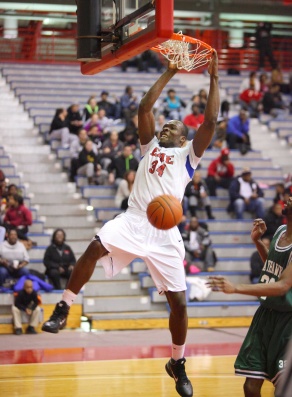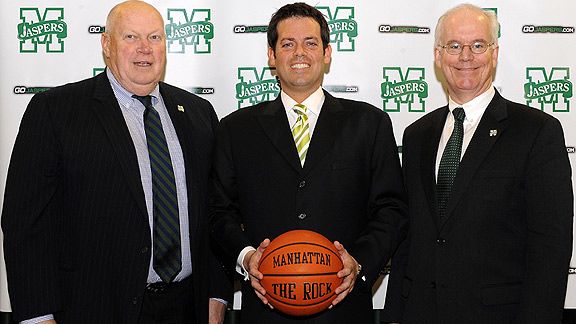 St. John's fans can expect a lot of this from their newest recruit, 6-9 power forward God's Gift Achiuwa. (Photo courtesy of JohnnyJungle.com)
St. John's fans can expect a lot of this from their newest recruit, 6-9 power forward God's Gift Achiuwa. (Photo courtesy of JohnnyJungle.com)“I am excited to come to St. John’s and New York City. I really like the coaching staff and the way St. John’s plays. They are a running team and that’s what I like, fast paced basketball,” said Achiuwa. “I also like the winning tradition of the new coaching staff. They came into the St. John’s program and turned things around in less than a year. I think that’s a good indication that the program is on its way back. I like the city and have been to New York a number of times, it is a great place to play and live. Madison Square Garden is the biggest stage in the world and it is a great opportunity to have The Garden as my home court.”
The 6-9 Achiuwa transfers to Queens from Erie Community College in upstate New York after choosing St. John’s over Washington and Cincinnati; and will have two years of eligibility left starting with the upcoming season, giving the Red Storm experience it so desperately needs after losing its ten seniors off last year’s NCAA Tournament team to graduation. Achiuwa joins junior guard Malik Stith, sophomore guard Nurideen Lindsey, and forward Dwayne Polee as the lone upperclassmen in Lavin’s second season as the successor to former coach Norm Roberts; who is now an assistant under Billy Donovan at the University of Florida.
“Gift is a talented frontline player who possesses tremendous size, strength, speed and skill. He is an ideal fit for our baseline-to-baseline attacking style of play," said Lavin. “The maturity Gift gained from two years of junior college basketball with a combined 55-6 record will make him a nice complement to what will be the youngest team in the country next season. He is fundamentally sound, and comes from a program with a tradition of winning, where a strong work ethic, playing hard and discipline is demanded on a daily basis.”
Alex Nwora, who coached God’s Gift at Erie Community College, a Division II school, echoed Lavin’s feeling of his star big man. “He’s a good leader who leads by example, the first one in (the gym) and (the) last one out," said the coach. "He’s a good kid, always makes eye contact, and he’s very coachable.” In addition to all of that, God’s Gift, a native of Nigeria, is also more than just an inside presence; as noted by his averages of just over 22 points and under 12 rebounds per game, albeit at the Division II level.
Achiuwa will likely split time with the aforementioned Norvel Pelle at the center position, as well as with fellow newcomer JaKarr Sampson at power forward; which could enable Dwayne Polee to slide down to the small forward position at various points during games to give St. John’s a somewhat bigger lineup than most fans are accustomed to when the Johnnies open their 104th season this November.





